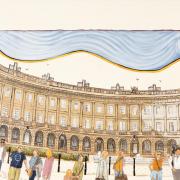A new contemporary art exhibition at Chatsworth reflects on 500 years of creativity, as Janine Sterland discovers.
Revealing a narrative of Devonshire family commissions spanning 500 years, the art found at Chatsworth is as much a part of the fabric the house as the surrounding grounds and garden.
These range from irreplaceable Old Master paintings and drawings to furniture, sculptures and ceramics.
Indeed, the breadth of historic and contemporary design flows through a home of 16 generations and is considered by many the finest, most diverse collection of its kind.
Through magnificent estate landscapes to more recent expressive portraits of Lucian Freud, Chatsworth’s exceptional design standards continue to celebrate innovative, talented artists in exquisite surroundings.
‘Contemporary works take on new meanings and a new beauty when placed into these extraordinary settings,’ says Glenn Adamson, co-curator of Mirror Mirror.

‘Chatsworth of course had an existing involvement in contemporary design – especially the work of Joseph Walsh, whose studio is near Lismore Castle, Ireland, the Irish residence of the Duke and Duchess of Devonshire and their family. Then there’s Joris Laarman, whose Maker bench was acquired for Chatsworth a few years ago.
‘The collections of contemporary ceramics are also relevant as background and served as an inspiration for us in devising the room-specific installations throughout Mirror Mirror.’
Showcasing the works of 16 international artists and designers and taking around two and a half years to plan, Mirror Mirror evokes experimental and interesting connections in Chatsworth through modern works of design.
These show a skilful and broad use of materials including glass, stone, silverware and wood, mirroring aspects of Chatsworth’s interiors, collections and irreplaceable pieces.
‘Throughout the exhibition, we hope the introduction of these contemporary works will also cast a new light on Chatsworth’s spaces and vice versa,’ adds Glenn.

‘Regular visitors will notice things they haven’t before, and people who know contemporary design will see it in a new way.
‘In the 16 practices we’ve chosen there is an amazing range and we hope visitors respond to this and are inspired to learn more about the field.
‘We also aim to highlight the diversity of contemporary design – with respect to geography, discipline, generation, and perspective.’
In selecting a varied range of contemporary artists whose work shows functional and intriguing designs, a tone of innovation has been set.
‘The hope is that everything in Mirror Mirror is both functional, at least by implication (as this is a key aspect of design), while also being intriguing – inspiring curiosity, especially within the possibilities of new technologies’ suggests Glenn.
Exploring practices of historic techniques in craftmanship alongside modern manufacturing methods, Joris Laarman’s Maker benches in the Painted Hall are ‘specifically about the phenomenon of digital manufacture whilst reflecting the historic patterns of the chequered floor,’ Glenn says.
‘The idea is that their components can be made on table-top sized equipment, then assembled, suggesting the tremendous possibilities of this new technology whilst mirroring the intricacy of historic patterns such as those found within the Painted Hall’s floor.’

This example, alongside others, demonstrates how many participating designers were inspired by the history of the house, its interiors and collections.
‘In one case, within Chris Schanck’s Cryo Cabinet, we highlighted this by placing mineral specimens within the piece,’ reveals Glenn.
‘But there are lots of examples of how designers’ choices were informed by the spaces and objects in them; Max Lamb with woodcarving; Andile Dyalvane’s installation of ceramics which responds to the antiquities in the space; Ndidi Ekubia with silver works and ceramic garnitures; and Faye Toogood with the panelling of the Oak Room.’
In exhibiting a major new art exhibition within centuries of historic interiors such as the Oak Room, Great Chamber, Chapel and amongst invaluable collections, there has, Glenn says, been numerous practical hurdles to navigate.
‘These interiors are of great historic significance and must be treated carefully; we had to be cognizant of scale, weight, and anchoring of large pieces,’ he says. ‘Although, in general, the pieces are of domestic size as we wanted to respect the existing scale of the rooms rather than disrupt them.
‘That said, many of the works suggest a kind of monumentality, such as Ettore Sottsass’s majestic glass pieces placed on historic furniture, dramatising their larger-than-life quality.’
Showcasing extremities in scale from Joseph Walsh’s enormous sculptural bed in the Sabine Room, to the delicate gleaming silverware of artist Ndidi Ekubia within an intimate space of the State Closet, for many exhibition pieces the concept of scale, as well as historic techniques in craftmanship, has formed an integral part of their overall design.
‘Ndidi Ekubia is a master silversmith who uses the same techniques artisans did in the 17th and 18th centuries,’ Glenn describes. ‘While Max Lamb’s chairs are made with modern equipment but are informed by historic woodwork.
‘Ingeniously, he has only cut and reassembled his pieces, rather than doing any subtractive carving, and this could be taken as a statement about efficient use of natural resources; the exhibition as a whole reflects on key issues of our time, including climate and sustainability.’
Taking a prominent position in Chatsworth’s State Music Room, Jay Sae Jung Oh’s throne, made from repurposed musical instruments, is an obvious example which reflects the key issue of sustainability with its repurposed musical instruments wrapped in cord.
Encasing discarded instruments such as a snare drum, French horn and an electric guitar within thousands of intricately cut leather strips, her work not only complements the 6th Duke’s 19th century gilded leather walls, but captures musical instruments in their form rather than through sound, mirroring the State Music Room’s 18th century ‘trompe l’oeil’ (trick of the eye) rear door violin painting which, in connection with Jay’s throne, also remains in an everlasting silence.
‘The historical significance and enchanting ambience of the space was truly inspiring,’ says Jay.
Upon receiving the commission a year ago, whilst being provided with details and photographs of Chatsworth’s interiors, Jay collated her inspiration and over a period of five months created a unique piece made from found objects wrapped in leather and plywood whilst using traditional craft methods.
Adhering to the room’s theme, she collected abandoned musical instruments and designed her work through several stages.
The initial part of the process, she explains, involved determining the type and scale of the furniture to be designed, followed by gathering abandoned objects and assembling them into a new form.
Once this model had been created, patterns were designed for the outer surface and wrapped with leather cords accordingly.
‘The choice of objects ultimately determines the structure,’ Jay describes. ‘I don’t normally sketch or build a prototype; the spontaneous and unplanned nature of the creative process is what lends beauty to this design.’
Bringing a fresh and diverse perspective to these historic surroundings, she feels, has been key to the success and overall impact of her design in the State Music Room.
‘I hope the audience can enjoy the captivating and fascinating juxtaposition of a throne created from modern abandoned objects within surroundings steeped in centuries of majestic history’ she says.
‘Working on the project was an incredible experience, especially seeing my work in person within the exhibition space - this was incredibly rewarding.
‘I feel honoured to exhibit my work alongside the great designers of our time in such a beautiful space.’
This viewpoint resonates with Glenn. ‘It’s been a real honour to work with designers of this calibre, in a historic site of this beauty and importance,’ he concludes.
‘Truly this project reflects the very best of design past and present, with an eye to the future.’
To discover more, visit: chatsworth.org



























